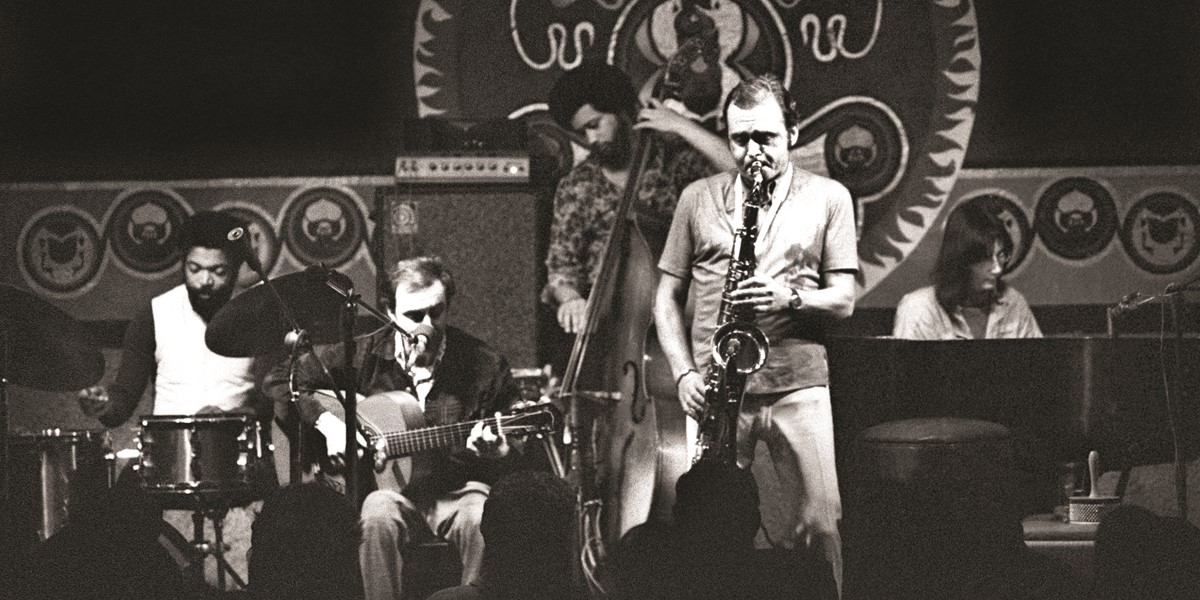Tuesday, July 16, 2019
Obituary: João Gilberto (1931-2019)
Russ Slater honours the legacy of the pioneer of bossa nova

João Gilberto performs alongside Stan Getz © Tom Copi
João Gilberto was 27 years old when he released his debut album, Chega de Saudade in 1958, said to be the first album of bossa nova. On the back cover, Tom Jobim wrote that ‘in just a little time he had influenced a generation of arrangers, guitarists, musicians and composers.’ Prescient words for a musician that the Brazilian public (or really anyone outside of a small group in Rio de Janeiro) barely knew anything about. Brazilian musicians had been searching for a modern sound, something to get away from the orchestral ballads and rootsy accordion folk of the time. Gilberto showed them a new sound could be possible with just a guitar and a whisper, and a revolution was born quietly but quickly. Chega de Saudade was the mission statement. Tracks like ‘Desafinado’ and the title-track, whose music had been composed by Tom Jobim, showed a mastery of the guitar that had not been heard before. The way he rhythmically plucked whole guitar chords has been compared to a distillation of a samba ensemble to just one instrument. It was this technique, as well as his vocals, softly spoken but paradoxically loud enough to fill a concert hall, that astounded all once Gilberto had developed his signature style.
Born in 1931 in the city of Juazeiro in the north-eastern state of Bahia, Gilberto moved to the state capital at 15 to study but soon gave it all up to become a singer, relocating to Rio in 1950 at the request of a vocal group there. His initial years in Rio appear fractured – he had little money as he’d quit the only non-musical job he had, and was even fired by the group who had invited him to Rio. After having little choice but to leave Rio to stay with friends, his sister and finally his parents back in Bahia, he returned to Rio in 1957, following intense spells refining his craft, as a different man and musician. He was more focused and wowed his fellow musicians with his new guitar beat and whispered vibrato-less singing. The story goes that when fellow musician Roberto Menescal heard him play, he took him to every friend and party he could find for three days solid, no sleep, so amazed was he by Gilberto’s singing and playing.
Gilberto followed up Chega de Saudade with O Amor, o Sorriso e a Flor (1960) and João Gilberto (1961), which were also released in the US, where a concert in November 1962 at New York’s Carnegie Hall saw Miles Davis and Dizzy Gillespie watch Gilberto, as well as Tom Jobim, Sergio Mendes and others, play live for the first time. The US jazz crowd were taking notice and saxophonist Stan Getz soon turned to Gilberto, the two making the definitive bossa jazz album, Getz/Gilberto, in 1964. Featuring soon-to-be-classic bossa tracks ‘Desafinado’, ‘Corcovado’ and ‘Só Danço Samba’, the album was propelled by the single edit of ‘The Girl From Ipanema’, which featured Astrud Gilberto’s breathy and unmistakeable vocals. It represented the apex of Gilberto’s popularity, as well as that of bossa nova. Gilberto’s productivity would slow, though he still sporadically released stunning albums, such as another self-titled release in 1973.
After spells in the US and Mexico, Gilberto returned to Rio in 1980, where he reportedly lived in the same apartment until he passed away, his growing reclusiveness becoming a constant topic of the Brazilian media. On the few occasions that he performed live, he demanded impeccable sound and quiet audiences – as if it was the only way he could compete with the musical epiphanies that he himself had created as a young man.

